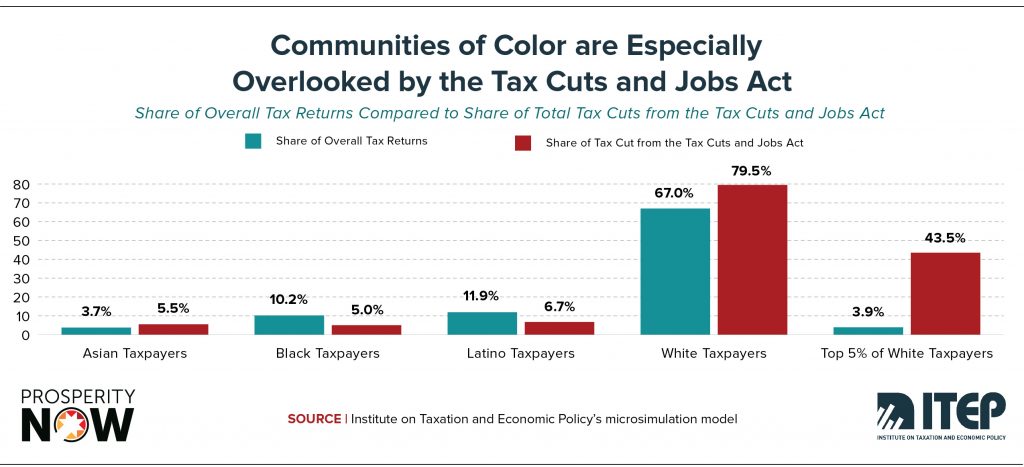Taxes are top of mind for many families as the April 18 income tax filing deadline fast approaches. The national conversation around taxes has changed in a lot of ways in recent years—some good and some bad—but I’m heartened by the growing recognition that tax policy is not race-neutral. As we look ahead to what comes next in our journey to a more race-conscious tax policy debate, it’s worth reflecting on how we got here and what we’ve learned along the way.
Everyone benefits from taxes because they support public programs and services aimed at keeping us educated, safe, productive, financially secure, and healthy. The tax code, however, has significant room for improvement. As a result of centuries of racial discrimination and economic exclusion, white families on average have far more wealth than families of color. This racial wealth gap is maintained and sometimes worsened by unfair tax laws such as preferential treatment of income from wealth over income from work.
With nearly 10 years of experience researching and writing on tax policy, my focus has consistently been on tax justice, with an eye toward realizing a system that remedies historical wrongs and charts a course to a more equitable future. In the time I’ve been doing this work, I’ve gradually shifted my focus more squarely to issues of tax and racial equity. Those concerns are key to how I envision improving the tax code.
Other people, including organizers, policy analysts, advocates, policymakers, and people across diverse academic disciplines like law, economics, sociology, history, and political science, are having the same evolution. People are convening, discussing, and speaking out about the history of tax laws and how they contribute to the racial inequities we see today. These conversations are solutions-based, focusing on how to enhance the tax code.
These important, invigorating discussions were made possible in large part because of pioneering research and discussion that began decades ago. These papers laid the groundwork for an interdisciplinary approach that illuminates how the tax code affects people of different races. Understanding the origins of these ideas is crucial to putting the fight for tax justice in context.
The Legal Academy Assembles the Building Blocks
Let’s begin with Jerome Culp’s 1991 essay, “Toward a Black Legal Scholarship: Race and Original Understanding,” where he urged legal scholars, particularly Black professors, to expose the delusions of the American legal system and how its treatment of slavery and Black people is forgotten by history. While it’s not a definitive starting place, this proclamation helped spark an academic movement, including among tax law professors who began investigating the relationship between race and tax law.
For example, law Professors Beverly I. Moran and William Whitford published a study in 1996 on how the design of the federal tax code often produces different outcomes for Black people than it does for white people. This study broke ground with its use of data as an instrument, arguing that racial differences in economic and social life in America, many shaped heavily by racism, allow white people to benefit more from the tax subsidies for wealth accumulation, retirement savings, and housing, among others. Moran and Whitford’s work was limited by the fact that filers do not provide their race on tax forms, so scholars lacked tax return data for estimating race. It’s a familiar problem to tax researchers even today, and one that ITEP and others have been working to address.
In 1997, one of Culp’s protégés, law professor Dorothy Brown, began writing on why race matters when looking at tax law. As a pioneer in the field, she’s devoted most of her career to answering that very question, especially as it relates to disparities between Black and white households. She’s continued to write academic and public essays. And in 2021, 30 years after Culp’s foundational essay, Brown released The Whiteness of Wealth, a groundbreaking best-seller explaining how differently the tax code treats Black and white people. In it, she discussed how the origins and implementation of tax laws related to inheritances, higher education, filer status, and other issues often solidify economic disparities between Black and white Americans.
Her book was successful at reaching a wide audience by translating academic jargon into plain language and offering concrete solutions. She also contributes through service on the relatively new Treasury Advisory Committee on Racial Equity. She is building a bridge between research and public engagement, making a major step forward in helping a wide audience understand racial inequities in our tax code.
Public Policy Researchers Add More In-Depth Data Tools
While scholars have explored these issues for decades, until recently there was no recognizable movement outside of academia discussing this relationship, let alone putting forth solutions. Research groups and community coalitions alike tended to focus their tax reform agendas on income and class, partly because of data limitations but also partly due to a lack of diversity in the field and a resulting lack of awareness or comfort with engaging in race equity discussions. While the tax justice movement has accomplished many great things, its lack of racial awareness caused it to sometimes miss the full picture of how people experience the tax code. As policy researchers, frankly, we were late.
Then, in 2018, ITEP became the first organization to incorporate racial data into a microsimulation tax model. We unveiled this new capacity with a paper, co-authored with Prosperity Now, spotlighting the racially inequitable effects of the federal Tax Cuts and Jobs Act of 2017, which directed more than 40 percent of its tax cuts to the tiny fraction of white households earning over $250,000 per year. More important than that single paper, however, was the way in which this new capacity has continued to inform the debate over federal, state, and local taxes since. Our findings showing the impact of taxes across race and ethnic groups have been featured in dozens of ITEP reports as well as in the media and in the work of numerous other organizations.
Just over four years after ITEP’s first major paper analyzing tax policies across race, the U.S. Department of Treasury unveiled a trailblazing report calculating the share of eight tax expenditures claimed by people of different races. This is the first research on racial disparities that used actual, confidential tax return data from the IRS. While the IRS data themselves provide no direct evidence on the race of people filing any given tax return, researchers at Treasury used a sophisticated method taking into consideration income, filing status, first and last name, and other variables to estimate whether each return was filed by a white, Black, Hispanic, or Asian household.
The key findings, while not necessarily surprising in the broad strokes, were jarring in the specifics. Although some policies like the Earned Income Tax Credit (EITC) provide meaningful benefits to Black and Hispanic families and may narrow racial disparities, others such as subsidies for capital gains and business income are heavily skewed toward white families, often wealthy ones. For instance, the analysis found that 90 percent of tax deductions for pass-through business income and 92 percent of the tax cut from preferential rates for capital gains and dividends flow to white families, even though these families account for just 67 percent of the overall population.
This landmark paper, and the executive order from President Biden that facilitated it, are welcome steps forward for racial justice advocates working on tax policy. But we can’t stop there. Large swaths of the federal tax code need further scrutiny. State governments should conduct similar analyses of their own tax codes. And, of course, lawmakers must act on the information uncovered through this work. The ultimate goal of investigating the impact of taxes and race is to help shape policy for the better, after all.
Collaboration Holds the Foundation for Rigorous Tax and Race Research
Placing race at the center of tax justice discussions took many decades. Some of the recent progress happened only because the tax field now has more – but still not enough – people of color in the debate. Conferences, webinars, and reports on how the tax code shapes racial inequities are becoming fixtures in how we advance our collective understanding. This collaborative work must continue.
These are not new issues. These are not new debates. These are not new laws. Understanding how tax policies shape the yawning racial inequities we see today is paramount to making any true progress in our society. The more we know, the more we grow.




